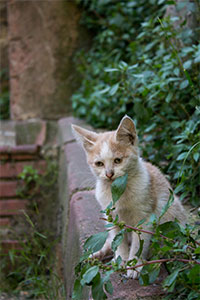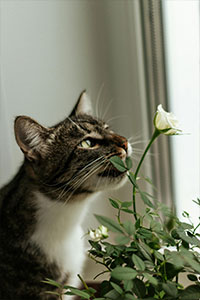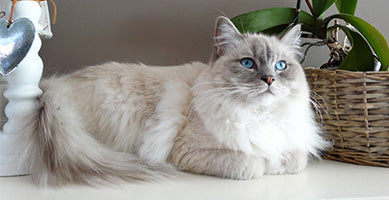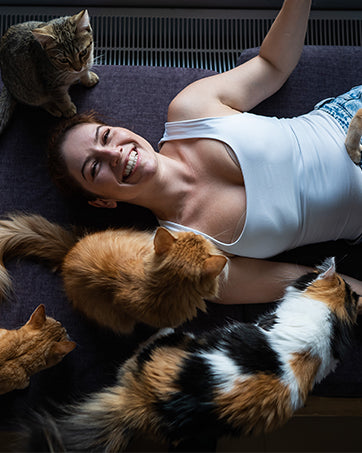Jessica W. Kelvin - Mar.05.2024
Why Do Cats Eat Grass?
7 Insights into Feline Behavior

What Colors Can Cats See?
Est. read time: 6 min.
UUnderstanding how our feline friends see the world is not just a curiosity—it's essential for ensuring their well-being and happiness. While myths abound regarding the extent of cats' visual capabilities, recent scientific studies offer fascinating insights into the reality of cat vision. This blog aims to dispel common misconceptions, answering questions about color blindness, the colors cats see best, their vision range, night vision capabilities, and how we can support their sight. Whether you're a cat owner or simply a cat enthusiast, join us as we explore the colorful world through the eyes of a cat.
Are Cats Color Blind?
The question of whether cats are color blind has intrigued many. Contrary to the widespread belief that cats see only in black and white, research indicates that cats do perceive colors, albeit differently from humans. Cats belong to a group of mammals with dichromatic vision—meaning they have two types of cones in their eyes, allowing them to distinguish between certain colors. While their color spectrum is not as rich and varied as that of humans, who are typically trichromatic, cats can indeed see shades of blue and green. Red and pink tones, however, may appear more muted and less distinct. This evolutionary trait suggests that cat vision is finely tuned to their lifestyle and environmental needs, prioritizing movement detection and low-light vision over a broad color palette.
What Color Can Cats See Best?
Cats can meow excessively for a variety of reasons, the more serious of which include illness, loneliness, stress, pregnancy, or old age. Or, your cat might simply be looking for attention or wondering why their food bowl is empty. Research shows that humans statistically are not great at deciphering the cause of a meow; so if you’re concerned about your cat language translation skills, you’re not alone. Here’s how you can tell the difference and understand why your cat won't stop meowing:
How Far Can a Cat See?
Cats possess remarkable visual acuity within a specific range. While they may not match the long-distance vision of some predators, their ability to see clearly up to 200 feet (about 60 meters) is impressive. Beyond this distance, objects become less sharp to a cat. This range is perfectly suited to their hunting style, which typically involves stalking and ambushing prey at closer distances. Additionally, cats excel in detecting even the slightest movements, a crucial skill for both hunting and evading predators. Their vision is optimized for life in the wild, focusing on survival skills over the ability to see distant objects clearly.

Do Cats Have Night Vision?
One of the most celebrated aspects of cat vision is their ability to see in low light conditions, often referred to as "night vision." Cats' eyes have a high number of rods, photoreceptor cells that are sensitive to low light, significantly more than what humans possess. This, coupled with the tapetum lucidum—a reflective layer behind the retina—enhances their ability to see in the dark by reflecting light back through the retina, effectively brightening the image they perceive. While cats cannot see in total darkness, their night vision is vastly superior to that of humans, allowing them to navigate and hunt effectively from dusk till dawn. This capability is a testament to their evolutionary background as crepuscular hunters, most active at twilight.
How Can I Support My Cat's Vision?
Ensuring your cat maintains optimal vision health involves several straightforward yet impactful measures. Firstly, regular veterinary check-ups are crucial, as veterinarians can spot and address eye health issues early. Nutrition also plays a vital role in eye health; foods rich in vitamins C and E, as well as antioxidants and taurine, support overall eye function. Creating a stimulating environment with toys and objects in colors cats can easily see, such as blues and greens, can enhance visual engagement. Avoiding potential hazards, like sharp objects or toxic plants, helps prevent accidents that could harm their eyes. Additionally, clean, well-lit environments support better vision, reducing the risk of injuries and enhancing their quality of life.
Cats:Theobromine Toxic Consumption
Most Cats: 1-10 lbs(0.45-4.6 kg), Large Cats11-25 lbs(5-11.4 kg)
Cacao Beans: Most Cats> 0.05 oz, Large Cats> 0.5 0z
Unsweetened Baking Chocolate: Most Cats> 0.2 oz, Large Cats>2 0z
Dark Chocolate: Most Cats> 0.5 0z, Large Cats>7 oz
Milk Chocolate: Most Cats>1.5 0z, Large Cats>16.5 0Z
White Chocolate: Most Cats>360 oz, Large Cats>4000 0z
Cocoa Powder: Most Cats> 01 0z, Large Cats>10z
Cocoa Bean Mulch: Most Cats>0.1 0z, Large Cats>1 0z

Showing making procedure is a good way to guarantee product quality
Stress Relief
Eating grass can also serve as a form of stress relief for cats, providing a calming activity that distracts from anxiety or boredom.


Get customer attention by clean visual and video
Instinctual Actions
Grass eating is an instinctual behavior that may stem from a cat's need to seek out alternative food sources or to induce vomiting to clear their stomachs of indigestible materials.
Additional Insights on Cat Vision
If your cat meows excessively after you’ve ruled out hunger and attention-seeking behavior, you’ll want to take them to your veterinarian for a checkup. Any abnormal behavior is a sign that something might be wrong. Common issues cats can develop include urinary disease or anxiety, so a good first step is to check for any health issues. Many issues can cause stress or pain, leading to excessive meowing.
When cats want to breed they make a lot of noise. Females yowl when they are in heat, while males yowl when they smell a female in heat. They can get very noisy and disturb not only you, but others in the neighboring area. A good way to prevent this type of meowing is to get your pet spayed or neutered.
How Can I Support My Cat's Vision?
Supporting and maintaining your cat's vision requires a combination of good nutrition, regular veterinary check-ups, and creating a stimulating environment. Here are some tips:
Nutrition: Ensure your cat's diet is rich in essential fatty acids, vitamins, and antioxidants. Nutrients like taurine, vitamin A, and omega-3 fatty acids are crucial for eye health.
Play and Stimulation: Use toys that stimulate your cat's natural hunting instincts. Toys that move unpredictably or have a variety of colors (especially in the blue and green spectrum) can help keep their vision sharp.
Check-ups: Regular veterinary examinations can catch and treat potential eye problems early. If you notice any signs of eye discomfort or vision changes in your cat, such as excessive tearing, cloudiness, or squinting, consult your veterinarian immediately.
Safe Environment: Protect your cat from sharp objects and toxic substances that could injure their eyes. Indoor cats generally face fewer risks, but it's still important to keep your home safe.
Article credit: Heidi Cohen (https://heidicohen.com/use-blog-to-sell/)
Digestive Aid
Grass acts as a natural laxative, helping cats pass hairballs or other indigestible items through their digestive tract more easily.
Elimination of Parasites
It's also theorized that grass eating may help cats eliminate intestinal parasites, although this benefit is more anecdotal than scientifically proven.
Additional Insights on Cat Vision
Cat vision is not just about seeing in the dark or spotting the slightest movements. It's intricately linked to their survival instincts and behaviors. Cats use their vision to assess distances accurately, an essential skill for calculating leaps or judging the proximity of prey or threats. Moreover, the positioning of their eyes gives them a broad field of view, allowing them to detect motion from a wide angle, which is crucial for spotting potential dangers or prey.
Different breeds may have variations in vision capabilities. For instance, breeds with larger eyes, like the Siamese, are often believed to have better night vision, although all cats are generally adept in low-light conditions.
Conclusion
Understanding cat vision opens up a new perspective on how our feline companions interact with the world. It's a blend of sharp instincts, evolutionary adaptations, and biological capabilities that allow them to thrive. By nurturing their vision through proper care and understanding, we can enhance our cats' quality of life and deepen the bond we share with them. Embrace these insights and watch your world—and theirs—become a more engaging and colorful place.

How to Safely Introduce Grass to Your Cat
Suitable Types of Grass
Certain types of grass are more beneficial and safer for cats, including wheatgrass, which is often sold as "cat grass."
Growing Your Own Cat
Grass
For the safety and health of your cat, consider growing your own cat grass at home. It's a simple and effective way to ensure they're getting a safe product.
Alternative Behaviors and Solutions
Dietary Supplements
If your cat shows an excessive interest in eating grass, it might indicate a dietary deficiency. Consult with a veterinarian about supplementing your cat's diet.
Behavioral Enrichment
Providing toys, climbing structures, and engaging activities can reduce your cat's inclination to eat grass by offering alternative forms of stimulation.
Why Do Cats Eat Grass?
Exploring the curiosity behind this behavior reveals a complex blend of nutritional, psychological, and instinctual factors. Understanding these can help cat owners provide better care and enrichment for their feline friends.
Owner Experiences and Advice
Personal Anecdotes
Many cat owners have observed their pets eating grass and have noted the benefits or concerns that came with it. Sharing these experiences can offer valuable insights for other pet owners.
Expert Recommendations
Veterinarians and animal behaviorists can provide professional advice on managing grass-eating behavior, ensuring it remains a safe and positive experience for your cat.
FAQs
Cats should not eat chocolate ice cream; not only is chocolate toxic to cats, but ice cream often contains toxic ingredient propylene glycol. Ingesting propylene glycol can lead to anemia in cats.
Say it at the end
Understanding why cats eat grass sheds light on their complex behaviors and the natural instincts that drive them. By providing safe, suitable grass and paying attention to the underlying reasons for this behavior, cat owners can ensure their feline companions lead happy, healthy lives.












